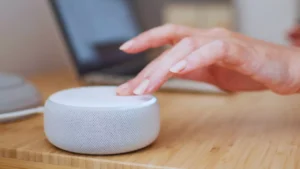Connecting speakers correctly is an important part of achieving the desired sound quality. There are several methods for connecting speakers, and it is important to understand their differences to achieve the best results.
In short, the spring clip method is the best way to connect speakers. This method is quick, easy, secure, and compatible with bare speaker wires and pin connectors.
This article will discuss the best way to connect speakers and the importance of using proper wiring and connection methods.
In This Article:
What Are the Different Types of Speaker Wire Connections?
Speaker wire connections are an essential part of any audio system, providing a path of electrical connection between the speaker and the amplifier.
The two main types of speaker wire connections are spring clips and binding posts. The different types come with their own set of benefits and drawbacks, so it’s important to weigh your options carefully before making a purchase.
Spring Clips
Spring clips are the most common type of speaker wire connection found in consumer audio systems. They are small, usually U-shaped metal connectors with wire terminals on each end. Spring clips can be used to quickly and reliably join two items together. The problem is that not all speaker cables work with them.
The terminals on spring clips are compatible with small gauge wire, so if you use a thicker wire, you will need to use a different type of connection.
Binding Posts
Binding posts are another type of speaker wire connection that is becoming increasingly popular. They consist of a metal post with a threaded hole that accepts larger gauge speaker wire. Binding posts provide a more secure connection than spring clips and are compatible with a wider range of speaker wires.
The drawbacks are that they are costlier and need a little more effort to attach.
Why Is Spring Clip the Best Way to Connect Speakers?
Here are a few reasons why spring clips are considered the best way to connect speakers:
Versatility
Spring clips are compatible with many wire gauges and types, including bare wire, spade connectors, and banana plugs. Because of this, they are a practical and adaptable option for establishing audio connections.
Ease of use
The use of spring clips requires no special skills or knowledge. Simply strip the wire, insert it into the spring clip, and tighten the clamp to secure the connection.
Durability
High-quality metals and sturdy construction ensure that your spring clips will last through years of daily use. They are resistant to corrosion and wear, which makes them a reliable and long-lasting choice for speaker connections.
Safety
Spring clips provide a secure connection that minimizes the risk of electrical shorts or loose connections. This is especially important for ensuring the safety of your home audio system.
Importance of Using Proper Wiring and Connection
Using proper wiring and connection methods for speakers cannot be overstated. Proper wiring and connection ensure that the audio system performs at its best, delivers high-quality sound, and minimizes the risk of damage to the speakers and other components.
Ensure The Correct Impedance
One of the key benefits of proper wiring and connection is that it helps to ensure the correct impedance match between the amplifier and the speakers. Impedance is a measure of the resistance of a circuit to the flow of alternating current.
If the impedance of the amplifier and the speakers is mismatched, it can reduce sound quality and potentially damage the amplifier or the speakers. By using proper wiring techniques, you can ensure that the impedance is correctly matched, resulting in optimal performance and sound quality.
Appropriate Gauge Wire
Another thing you should look at is the use of appropriate gauge wire for the speaker connections. The wire gauge refers to the thickness of the wire, and it is important to use the correct gauge to ensure that the wire can handle the amount of current being drawn through it.
Using too thin wire can result in a loss of sound quality and potentially damage the speakers and amplifiers due to overheating.
Safety of The Audio System
In addition to the technical considerations, proper wiring and connection methods can also help ensure the audio system’s safety. Improper wiring can create a risk of electrical shock or fire, which can be dangerous and potentially damaging to both the system and the surrounding environment.
Different Types of Wire Connectors
Speaker wire termination is essential for connecting speakers to a power source and ensuring proper sound quality. The type of termination used will depend on the type of speaker wire, the type of power source, and the individual’s preference.
Below are four types of speaker wire termination that can be used in the home or studio setting.
Bare Wire
One of the simplest and most cost-effective ways to terminate the speaker wire is to simply connect the wire to the speaker without any additional connectors. This is often done by stripping the insulation from the wire and inserting it into the terminals on the speaker.
It should be noted, however, that this type of connection is not as secure as other methods and can be more prone to failure.
Banana Plugs
Banana plugs are one of the most popular types of speaker wire termination. These plugs are designed to be inserted into the speaker terminals and are connected to the speaker wire with a simple screw-in connection.
This type of termination is more secure than the bare wire connection and allows for easy disconnection and reconnection of the speaker wire.
Spade Connectors
Spade Connectors are connected to the speaker wire with a simple crimp connection. This type of termination is more secure than the banana plug connection and allows for easy disconnection and reconnection of the speaker wire.
Pin Connectors
Pin Connectors are connected to the speaker wire with a simple solder connection. This type of termination is more secure than the banana plugs or spade connector connections and allows for easy disconnection and reconnection of the speaker wire.
Step-by-Step Procedure to Connect Speakers and Amplifiers
Here is a step-by-step guide to connecting the wires to your amplifier and speakers.
Step 1: Gather The Necessary Materials
You will need speaker wires, a spring clip (recommended), an amplifier, and speakers. Make sure you have the proper gauge of wire for your setup.
Step 2: Connect The Amplifier to The Speakers
Connect the positive wire of the amplifier to the positive terminal of the speaker. Repeat this step with the negative wire and the negative terminal. Make sure the wires are tight and secure.
Step 3: Connect The Spring Clip
Connect the banana plugs to the ends of the wires. Make sure the positive plug is connected to the positive wire and the negative plug is connected to the negative wire.
Step 4: Insert The Spring Clip into The Amplifier and Speaker Terminals
Make sure the positive plug is inserted into the positive terminal, and the negative plug is inserted into the negative terminal.
Step 5: Power On the Amplifier and Test the Speakers
Turn on the amplifier and play some music. Make sure the sound is coming from both speakers.
Conclusions
After reading this article, you should know that the best way to connect speakers with wires is to use high-quality speaker wire that is specifically designed for the sound system being used. Make sure to match the gauge of the wire to the impedance of the speakers for optimal performance. Additionally, it is important to use connectors that are of the same quality as the wire to ensure a strong connection and no interference.
Frequently Asked Questions
What Type of Speaker Wire Should I Use?
For most systems, using about 16-gauge speaker wire is recommended. However, if the speaker is located far away from the amplifier or receiver, then a thicker, 14-gauge wire may be necessary.
Are RCA Cables Better Than Speaker Wire for Connecting Speakers?
This depends on the type of system you have and the distance between the amplifier/receiver and the speakers. In general, speaker wire is more reliable and provides better sound quality, but RCA cables can be easier to set up and more affordable.
Is It Possible to Connect Multiple Speakers to The Same Amplifier?
Yes, it is possible to connect multiple speakers to the same amplifier. However, you will need to make sure that the amplifier is powerful enough to handle the load.





